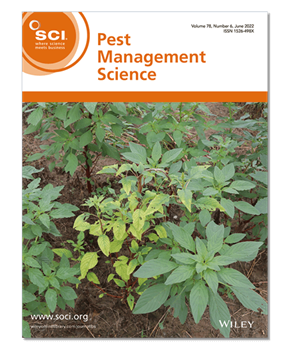JOURNAL HIGHLIGHTS BY STEVE RANGER
Anthracnose is a fungal disease affecting chilli plants, and Colletotrichum capsici is the major species responsible.
Common symptoms include aerial blights, leaf spots, and pre- and post-harvest fruit rot. Infections can lead to significant crop losses, in some cases reaching 80%. It’s a pathogen that can be seed-borne, soil-borne or airborne, all of which means it poses a threat to both seed and fruit quality.
Traditional management of the disease relies on chemical fungicides, but there is a pressing need for more sustainable solutions. However, recently nanotechnology has emerged as a promising option because it can improve plant immunity and morphophysiological traits and also offer strong antifungal properties, potentially offering a better alternative to traditional fungicides.
In a new study, published in SCI’s journal Pest Management Science, researchers looked at the use of silver nanoparticles (AgNPs), which have demonstrated antifungal properties against multiple pathogens, to treat C. capsici-induced anthracnose disease in chilli plants.
The researchers noted that AgNPs influence plant physiological responses by regulating osmolytes such as soluble sugars, amines, enzymes, proline, and glycine betaine, and by modulating stress signalling pathways. At the molecular level, they act as abiotic elicitors, generating reactive oxygen species and activating calcium ion signalling, which are essential in triggering systemic acquired resistance.
In their study, the team of international researchers explored the fungicidal effects of AgNPs on C. capsici and their role in activating chilli plant immunity.
‘Our findings demonstrate the dual role of AgNPs in both direct pathogen inhibition and immune stimulation, laying the foundation for their application in managing fungal diseases in other vegetables as well,’ the researchers say.
‘Given the limited understanding of AgNPs in enhancing chilli plant immunity, we hypothesised that AgNPs possess both antifungal activity against C. capsici and the ability to trigger plant immune responses through physiological and molecular mechanisms,’ they note.
This study aimed to explore these dual roles of AgNPs in managing chilli anthracnose and to assess their potential in improving plant health and soil nutrition. ‘The ultimate goal was to support the development of sustainable farming strategies through the application of nanotechnology, say the researchers.
The researchers found that the antifungal efficacy of AgNPs against C. capsici increased with rising concentrations. While lower concentrations showed limited inhibition, higher concentrations, as detailed in the full research paper, significantly reduced fungal growth. They also found that the expression of pathogenesis-related and antioxidant genes was significantly upregulated in chilli plants treated with AgNPs.
‘To the best of our knowledge, this is the first report demonstrating the protective effects of AgNPs against anthracnose in chilli through the activation of plant defence genes. This provides strong evidence that AgNPs can induce innate immunity and suppress disease development,’ they add.
The application of AgNPs ‘significantly reduced’ visible anthracnose symptoms in chilli fruits, the researchers say, noting that this supports their potential role as a substitute for conventional anthracnose control methods.
The findings support the idea that AgNPs function not only as antifungal agents but also as immune stimulants, the researchers said. ‘Treated plants exhibited improved nutrient uptake and preserved tissue integrity, suggesting that AgNPs contribute to overall plant health and productivity under biotic stress conditions,’ they said.
While their results demonstrate the potential of AgNPs as sustainable alternatives to conventional chemical pesticides, improving plant health and soil quality, their long-term environmental impacts, including risks of bioaccumulation and ecological safety, require further investigation.
‘Future studies incorporating transcriptomic profiling and functional genomics will be essential to elucidate the molecular mechanisms influenced by AgNPs and to promote their responsible use in sustainable agricultural systems,’ they add.
Silver nanoparticles enhance chilli resistance against Colletotrichum capsici through dual antifungal and immunity-inducing mechanisms
Ghulam Muhae-Ud-Din, Muhammad Jabran, Rimsha Abid, Maqsood Ahmed Khaskheli, Mir Muhammad Nizamani, Guang-Dong Geng, Guy Smagghe, Yong Wang
Pest Management Science
doi.org/10.1002/ps.70127






